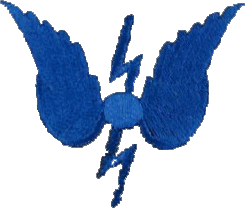|
NOTES. | |
Up until its introduction of this equipment in the mid 1960s orders throughout a warship was passed using:
a. Tannoys.
b. Loudhailers.
c. Runners/Messengers.
d. Hand signals.
e. Cupped-hand shouts.
f. Sound powered telephones.
g. Voice pipes.
h. Communication Branch (W/T or V/S) operated portables - Type 634 (also known as the Type A3), the traditional sea-boat set, or the smaller and less versatile Type 625 (also known as the Type A40).
This equipment revolutionised the way orders and instructions were passed internally, but apart from its use by members of the Visual Signalling Branch, few in the Wireless Telegraphy Branch ever got to use it. Apart from its obvious practical uses, it became almost a fashion item, and no self respecting, middle ranking executive officer, would be seen on duty without one hanging around his person.
It was used on the bridge to assist in conning, manoeuvring/tug work, in the waists for boat-work, for all aspects of a RAS, control of internal incidents (NBCDX, fires etc), on the FX for anchor work, on the AX for helicopter operations/Helo transfers, indeed for every need to pass orders and instructions within the ship and to other units operating in close proximity to the ship. It changed the way the Navy did things at sea. It was also used in shore establishments and was instrumental in enhancing the IS (Internal Security) of the Bikini Security System.
When it first arrived in the Fleet it was known as the STORNO, a shortening of its proper name Stornophone, a brand name made by Redifon, but even after it was officially changed when the new NATO/UK Joint nomenclature was introduced in 1967 it kept its name.
The NATO/UK Joint nomenclature reflected the Country of Origin, the use/purpose of the equipment, the sponsor. In this case:
UK - United Kingdom
PRC= man Portable Radio Communications Transmit and Receive.
The numbers reflect the following:
001 to 300 - Royal Navy
301 to 600 - Army
601 to 999 - RAF
The category under which this equipment was placed was known as the SSRP (Standard Short Range Portable) and it replaced the existing SSRP namely the Types 634 (A3) and the Type 625 (A40), although the Type 634 continued its role in the category SMRP (Standard Medium Range Portable).
The first of the range was called STORNO 512 which became the UK/PRC/001 and the STORNO 512(R) which became the UK/PRC/002. The 001 was a hand-held device necessitating it being put to the mouth or the ear to talk and listen, and wasn't weather proof. The 002 was weather proof, connected by a curly cable to a microphone/loudspeaker box which clipped to the upper part of the jacket/woolly jumper. Neither of these early sets could be used where there was a danger of igniting ammunition, fuel etc, so they were very limited and their use strictly controlled.
To overcome this potential danger from the 001 and 002 , the 003 (STORNO 512I - the I for India) and 004 (STORNO 512 RI) were introduced. These were the I.S. models (Intrinsically Safe) which literally meant that they could be operated inside magazine, next to petrol cans, alongside armed aircraft waiting on the flight deck etc with no fear of a transmission causing a spark or a destructive E/M pulse. This was the complete answer. The 003 (like the 001) was not weather proof and was hand-to-mouth, and the 004 followed the 003: for obvious reasons the UK/PRC/004 became the 'king' of the range.
|



